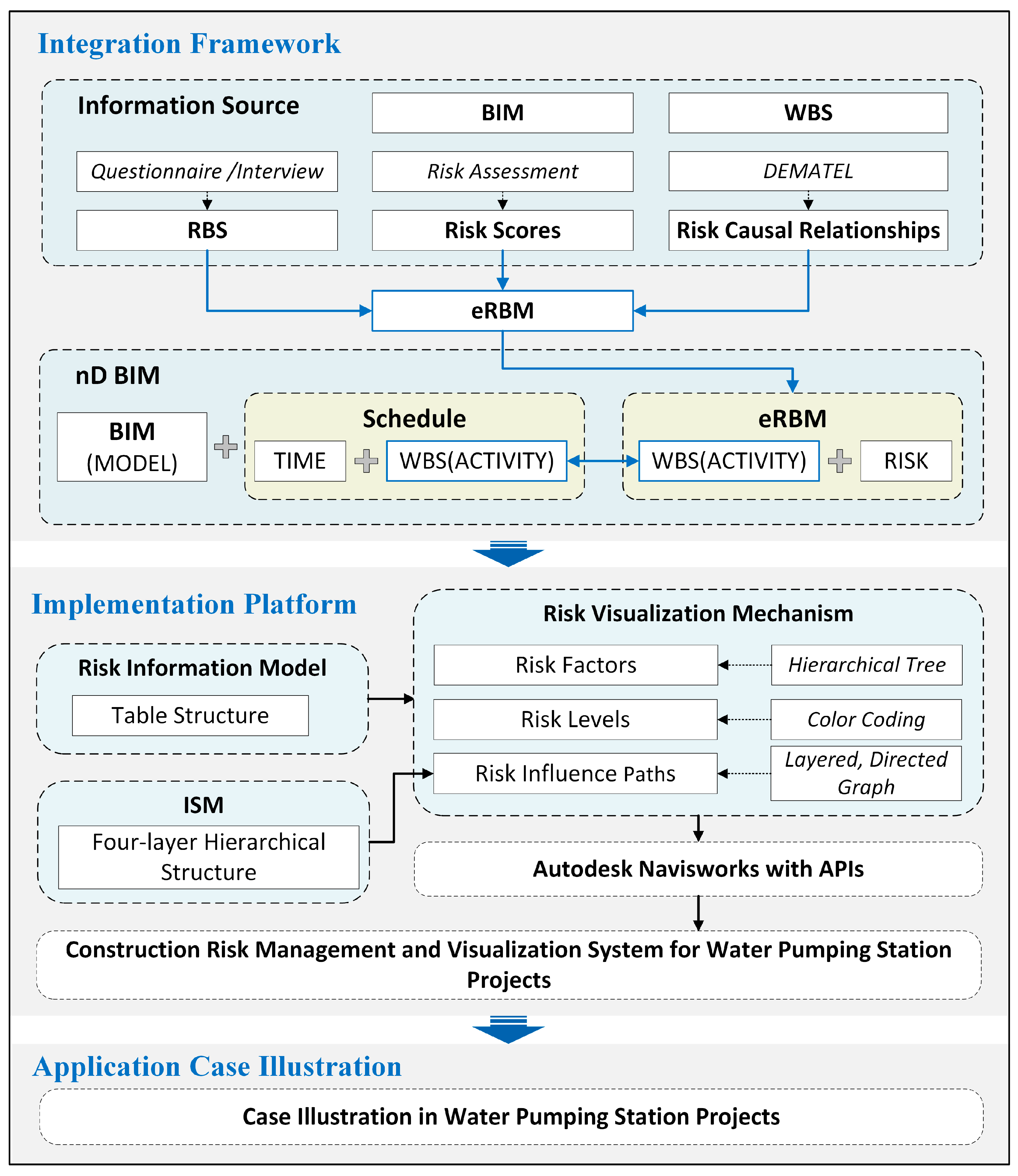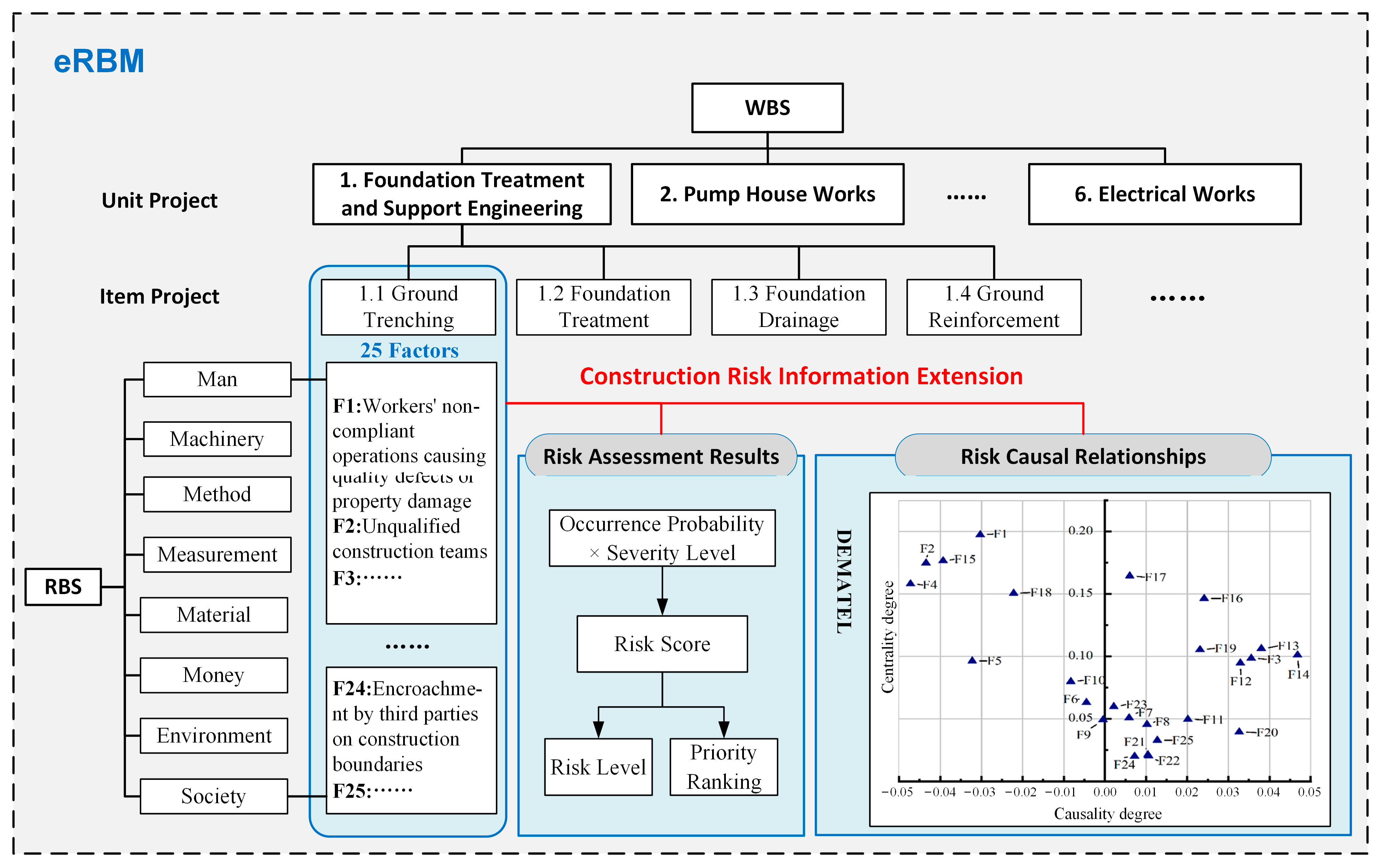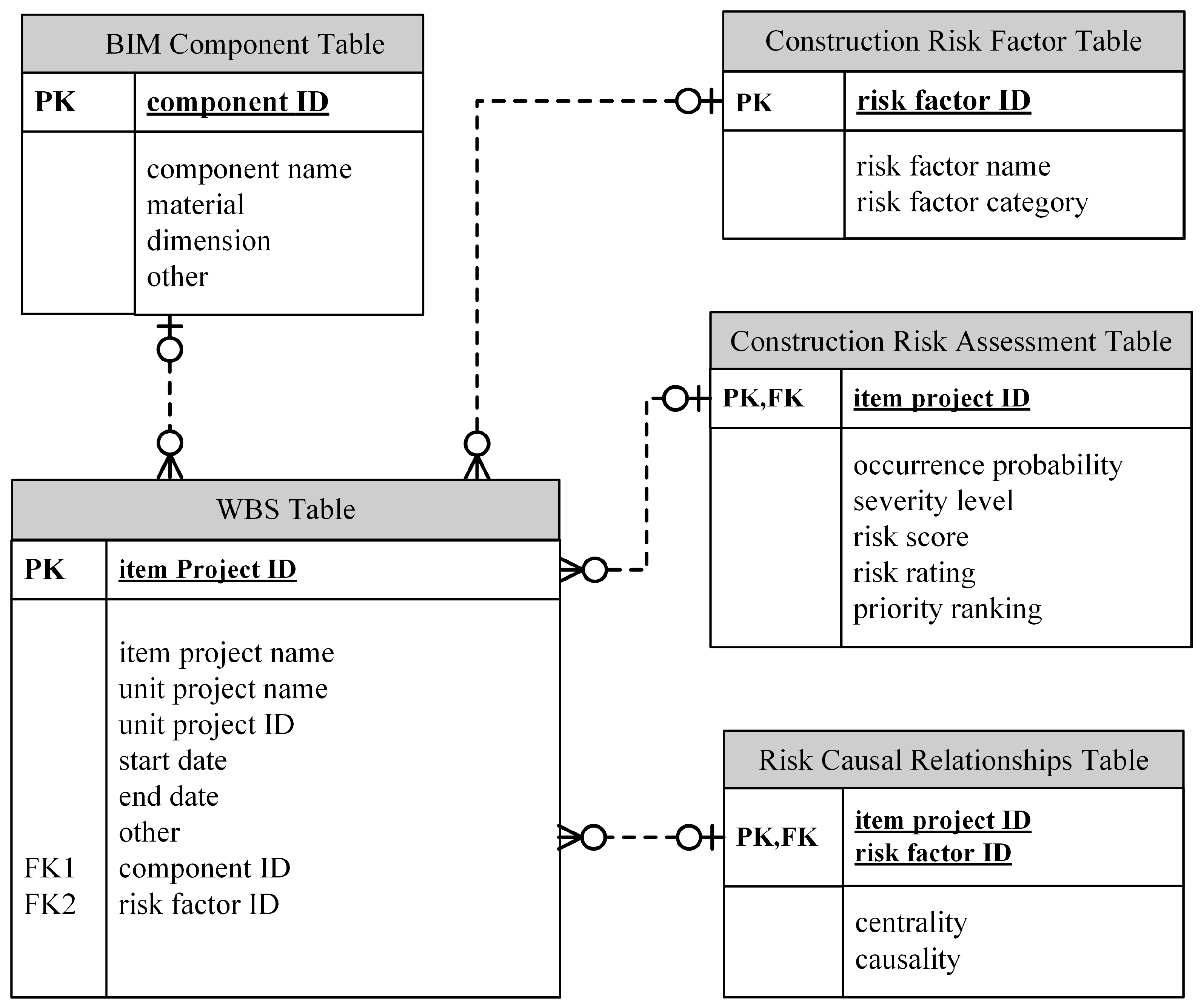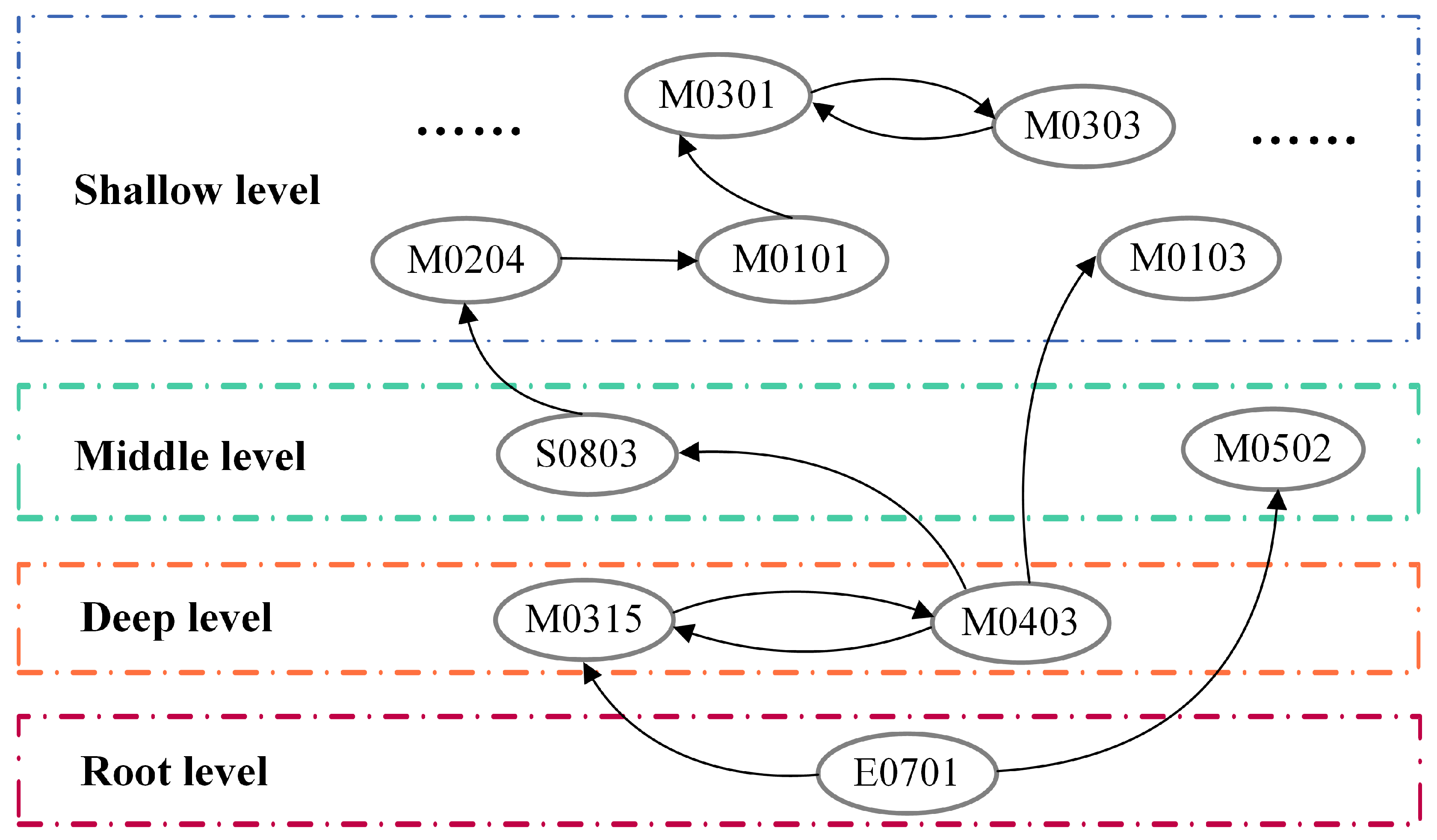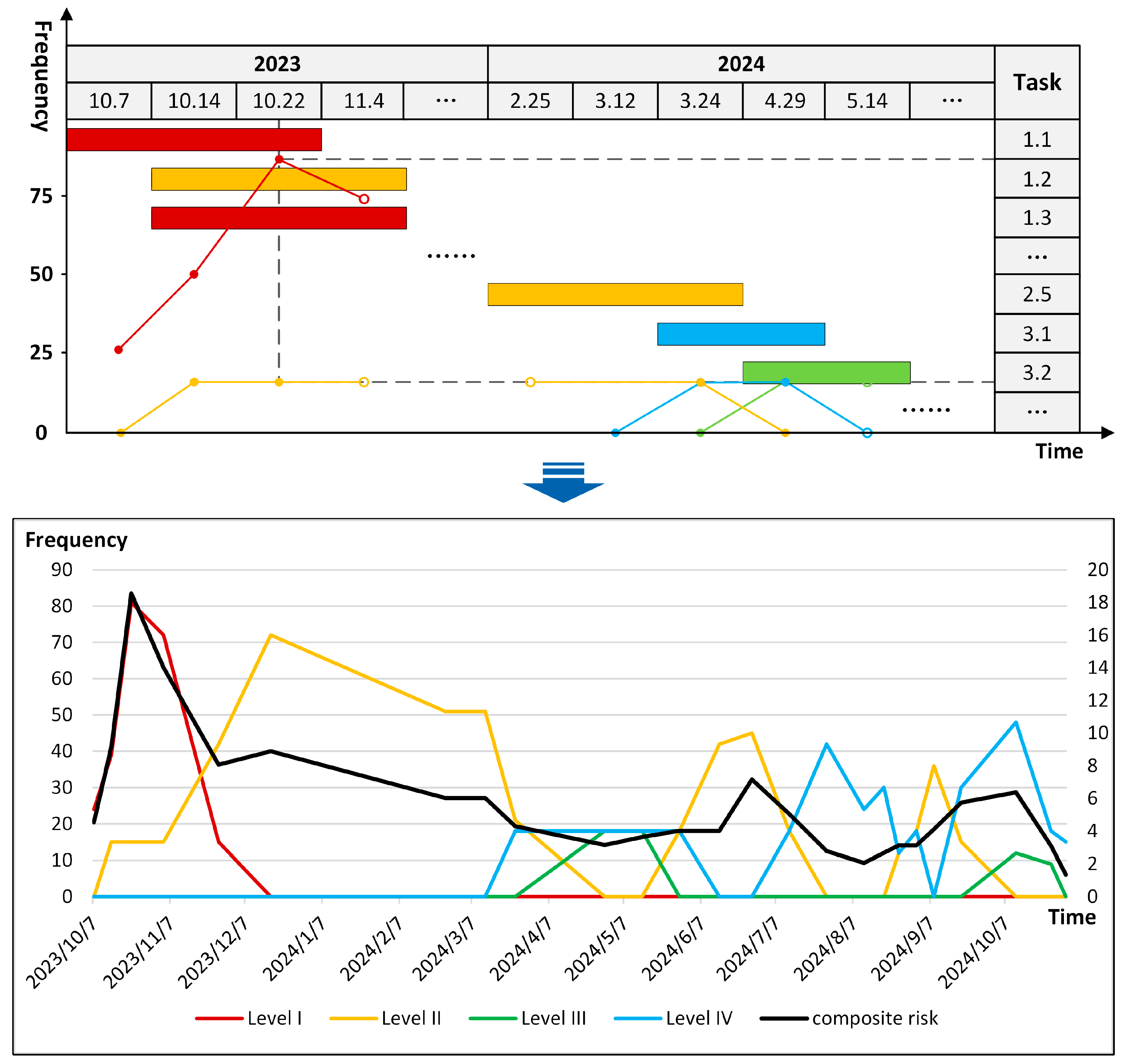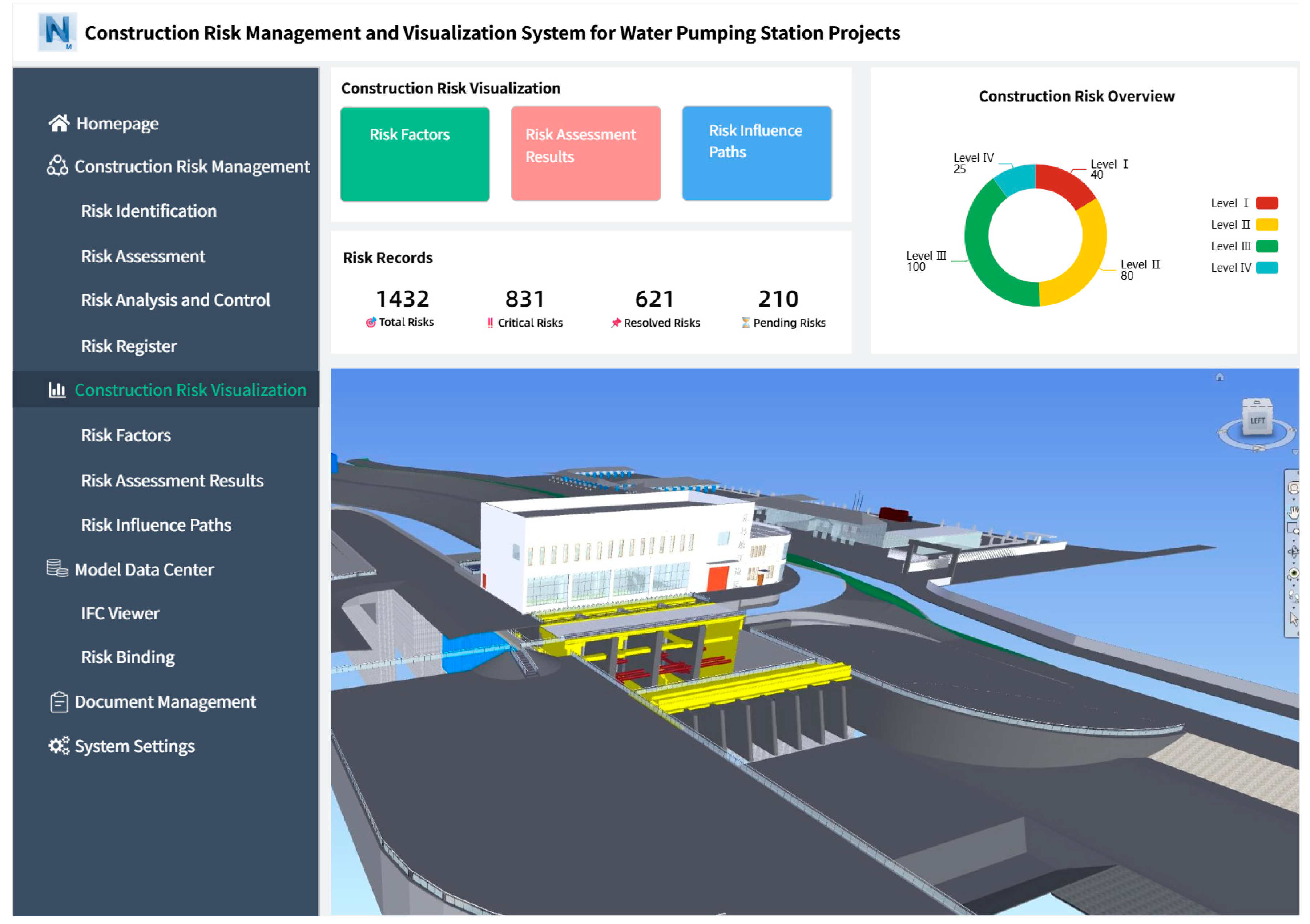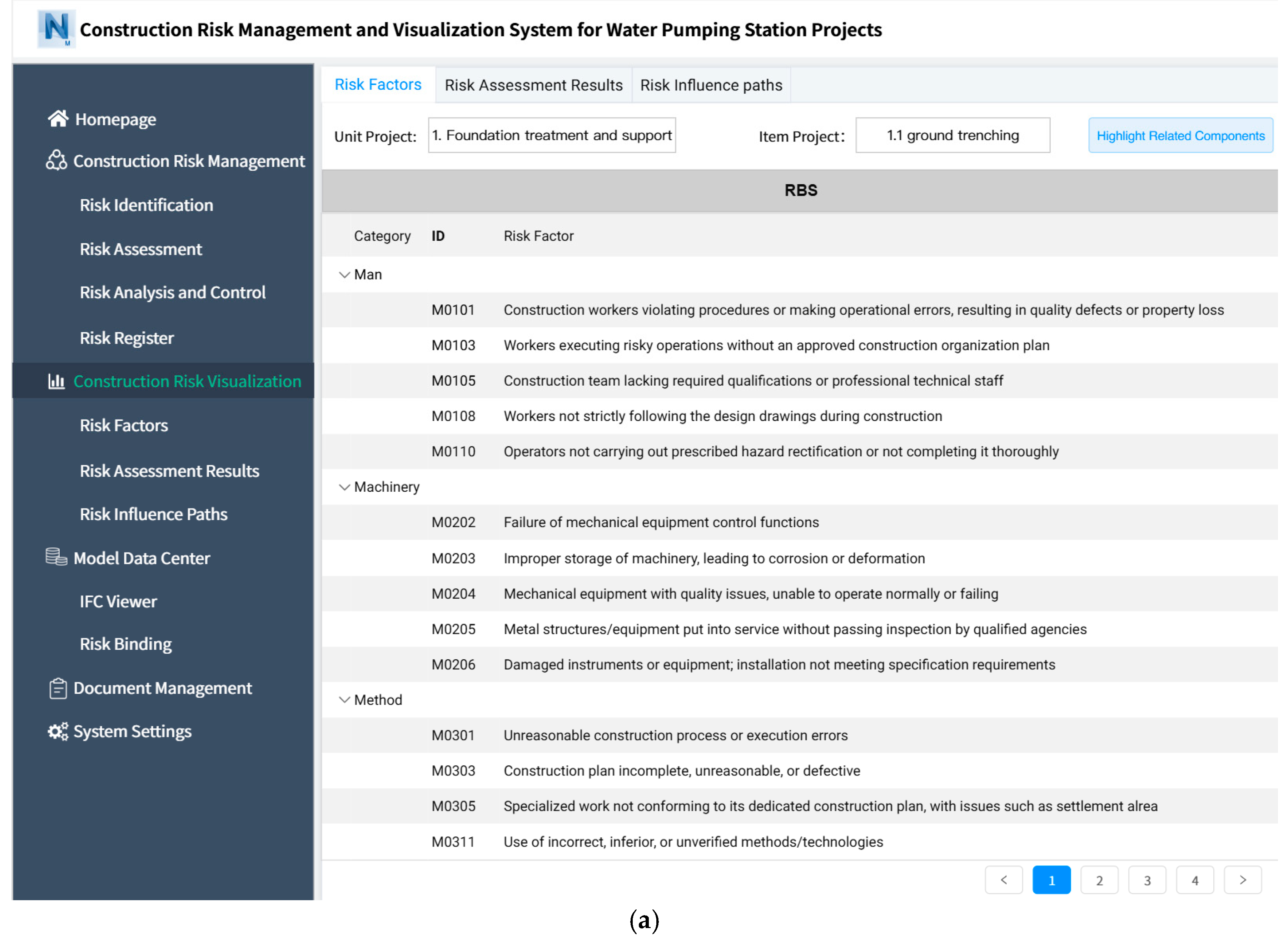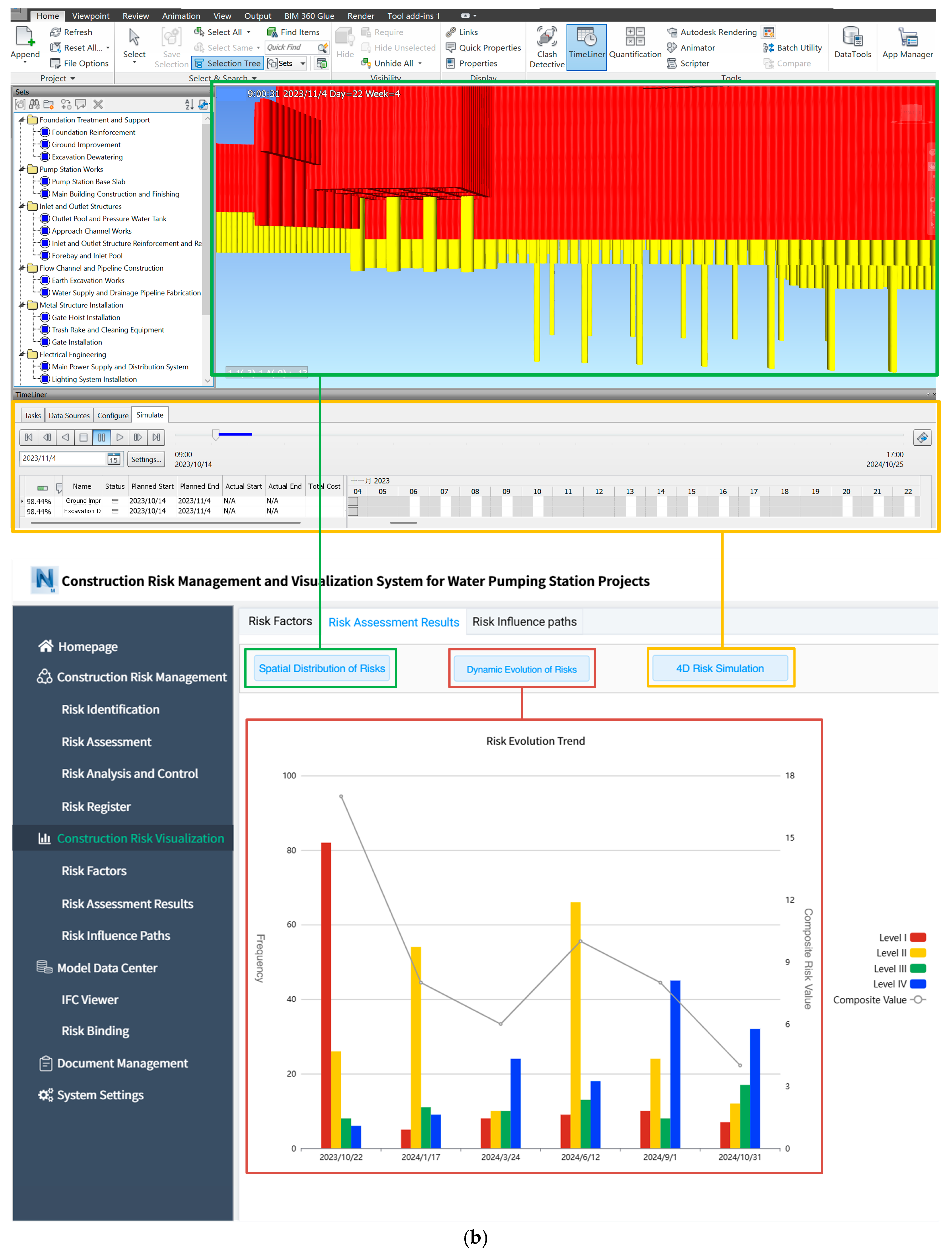1. Introduction
With the advancement of the National Water Network initiative, inter-basin water transfer projects and large-scale hydraulic infrastructure have become more critical for achieving spatial equilibrium and systematic governance of water resources across China. Among these infrastructures, water pumping stations play a pivotal role in water regulation and management. They serve essential functions such as flood control, drainage, and irrigation support and provide a powerful mechanism for the rational allocation of water resources [
1]. Modern water pumping station construction is an inherently complex process that requires the coordination of funding, personnel, construction technologies, environmental and site conditions, and potential natural hazards. These factors contribute to a wide range of risks that must be carefully managed to meet the stringent standards of high-quality hydraulic infrastructure development. In particular, high-risk construction activities, such as deep foundation excavation, operation under complex geological conditions, and large-scale concrete structures [
2], often pose significant challenges. Inadequate risk management in these areas may lead to serious outcomes, including structural damage or collapse, budget overruns, construction delays, and even personal injury or loss of life. Therefore, it is imperative to enhance fine-grained risk management during the construction phase to reduce potential hazards and ensure water security.
Given the inherent complexity of construction risk management, a variety of systematic methods, both qualitative and quantitative, have been developed to support the identification, assessment, and analysis of risks [
3]. Since construction risks often stem from the interaction of multiple contributing factors, researchers have increasingly focused on uncovering the interrelationships among risk factors and revealing the underlying mechanisms that drive risk propagation. For pumping station projects, this feature of risk coupling is particularly pronounced. Their construction is often constrained by complex geological conditions, stringent structural performance requirements, and parallel multi-process operations, all of which create a unique and highly sensitive risk environment. Therefore, classifying construction risks in pumping station projects and examining the interrelationships among these risk factors constitutes a necessary foundation for this study. Although many existing studies have provided valuable theoretical insights, their practical application remains limited. Many construction workers and on-site managers lack specialized training in risk management and often struggle to interpret complex analytical outputs or numerical models [
4]. This disconnect highlights the need for more accessible and intuitive tools. To bridge this gap, translating quantified risk data into visual formats has become essential for enhancing the usability of risk management systems.
Building Information Modeling (BIM), as a widely adopted digital technology in the construction industry, not only supports project lifecycle management but also plays a critical role in risk identification and control during the design, construction, and operation phases. Its strengths in visualization, integration, and simulation provide a solid foundation for data consolidation and intuitive representation in construction risk management. Accordingly, this study takes BIM as the core platform and focuses on the management and practical application of construction risks in water pumping station projects, with the aim of exploring visualization-based approaches for risk control. A considerable number of studies utilize basic color-coding techniques to link BIM components with predefined risk levels, enabling intuitive visualization of the spatial and temporal distribution of risks and enhancing stakeholders’ perception of potential hazards [
5]. However, while these methods offer preliminary insights, they often fall short in actual project contexts where risk identification, causal analysis, and dynamic assessment are key concerns for construction risk managers. Most current BIM-based visualization techniques lack the capacity to represent the interdependence and evolution of risk factors in a comprehensive and meaningful way.
To address this gap, this study proposes an integrated BIM–risk information integration framework tailored for water pumping station construction. A key contribution is the development of an extended Risk Breakdown Matrix (eRBM), which systematically organizes risk factors, assessment levels, and causal relationships. The eRBM is tightly linked to the BIM model through the proposed integration framework, enabling seamless association between physical components and associated risks. To support practical application, a visualization tool was developed using BIM secondary development techniques. The system architecture consists of three core components: (1) a structured risk information model to manage heterogeneous construction and risk data; (2) a risk influence path analysis module utilizing the Decision-Making Trial and Evaluation Laboratory–Interpretive Structural Modeling (DEMATEL–ISM) method to uncover causal relationships and hierarchical risk structures; (3) a spatiotemporal visualization mechanism that enables intuitive exploration of evolving risks. All data are managed using a tabular format, allowing the definition of multidimensional relationships across BIM components, construction schedules, and risk attributes. Based on this structure, the visualization mechanism is implemented through a custom Navisworks plug-in, developed via Application Programming Interface (API). The resulting prototype enables users to spatially identify risk sources and monitor their temporal evolution throughout the construction lifecycle, thereby effectively addressing critical limitations in existing risk integration and visualization methods for complex water infrastructure projects.
5. Implementation Platform
To enable effective data manipulation and functional implementation, five key design tasks were undertaken: (1) the development of risk information model, (2) the analysis of risk influence paths, (3) the design of risk visualization mechanism, (4) the construction of implementation architecture, and (5) the design of system prototype. These are described in detail below.
5.1. Risk Information Model
To support the integration of the three types of information sources, BIM, WBS, and eRBM, this study adopts a tabular data structure. This structured approach provides a clear and systematic basis for data-level integration, enabling efficient linkage and management across the datasets. The overall structure is illustrated in
Figure 4.
Initially a structured risk information model was designed, comprising five interrelated tables: the BIM component table, WBS table, construction risk factor table, construction risk assessment table and risk causal relations table. In the BIM component table, the component ID serves as the primary key, with additional attributes such as component name, material type, and dimensions, capturing the physical and functional properties of each model component. To ensure the uniqueness of each component, this study generates unique component IDs by combining type codes (e.g., “01” for support structures and “02” for pipelines) with serial numbers. For instance, “01-001” denotes the first support structure component.
The WBS table uses the item project ID as its primary key and includes information such as the item project name, unit project name, unit project ID, construction start and end dates. A hierarchical coding system is adopted to decomposition of construction tasks. The six unit projects, such as “foundation treatment and support”, “pump house construction”, and “inlet and outlet structures”, are assigned top-level numerical codes in the WBS. The 27 item projects are assigned second-level codes to reflect their relationship to the corresponding unit projects—for instance, “1.1” refers to the “ground trenching” task under the “foundation treatment and support” unit project. To facilitate data linkage, the WBS table also incorporates component ID and risk factor ID as foreign keys, connecting to the BIM component table and the construction risk factor table, respectively.
The construction risk factor table is structured around the risk factor ID as the primary key, with additional fields capturing the name and category of each risk factor. Following the 6M1E1S risk classification system, each individual risk factor is assigned a unique ID under its respective category. The ID coding follows the format “X-XX-XX”, where X represents the first letter of each major category in the 6M1E1S risk classification system. The middle XX indicates the category number within the 6M1E1S system, ranging from 01 to 08, corresponding to different categories (e.g., “Man” category is 01, “Machinery” category is 02, and so on). The final XX represents the specific risk factor number within that category, starting from 01, and sequentially identifies different risk factors within each category. For example, “M0101” refers to “unsafe operation or execution errors by construction workers resulting in quality or property loss” under the “Man” category.
The construction risk assessment table adopts the item project ID as its primary key and stores key risk evaluation metrics—such as risk occurrence probability, severity level, risk score, risk level, and risk priority ranking—evaluated specifically at the item project level.
Finally, the risk causal relationships table contains the centrality and causality values of the risk factors, which are linked to their respective item projects through the item project ID and risk factor ID.
This relational model enables seamless integration of construction, BIM, and risk data, providing a solid foundation for dynamic risk visualization and management.
5.2. Analysis of Risk Influence Paths Based on ISM
The authors’ previous study explored the causal relationships among risk factors at the item project level using the DEMATEL method. Building upon this foundation, this study further applies Interpretive Structural Modeling (ISM)—a methodology originally developed by John N. Warfield in 1973 to construct hierarchical models of interrelated factors in complex systems [
48]—to analyze the influence paths of construction risks. Specifically, the direct influence matrix derived from DEMATEL is transformed into a binary adjacency matrix, which serves as the input for the ISM process. This transformation enables the identification and representation of direct relationships among risk factors. The ISM approach involves three main steps, as outlined below:
- (1)
Establishing the overall influence matrix
The DEMATEL method evaluates the strength of relationships among risk factors in item project by constructing a direct influence matrix
, as shown in Equation (1).
where
represents the influence of factor
on factor
as assessed by the
p-th expert. This matrix is normalized using Equations (2) and (3) to obtain the normalized direct influence matrix
.
Then, the comprehensive influence matrix is obtained, as shown in Equation (4).
I in Equation (4) is the identity matrix.
- (2)
Establishing the reachable matrix
Since the matrix
T does not account for the self-influence of each factor, the identity matrix
I is introduced and combined with
T to derive the overall influence matrix, as shown in Equation (5).
The reachable matrix is derived through the overall influence matrix, as indicated in Equation (6) and (7).
In Equation (7), denotes the threshold value, which is typically determined by experienced experts based on the complexity of the system. Setting an appropriate threshold helps simplify the complex interrelationships among factors within the system, thereby facilitating a more reasonable hierarchical structure.
- (3)
Establishing the hierarchical structural model
The set of factors influenced by the factor
is referred to as the reachable set
, while the set of factors that influence the factor
is referred to as the antecedent set
. In accordance with the reachable matrix,
and
are obtained using Equations (8) and (9). It is then checked whether the reachable set and the antecedent set satisfy Equation (10). Factors that satisfy Equation (10) are identified as the first-level factors of the system. The corresponding rows and columns are then removed from the reachability matrix. This process is repeated using Equations (8)–(10) until all factors are classified.
By removing factors layer by layer, the factors are finally divided into different hierarchies. Factors are iteratively removed and classified into hierarchical levels, with the reachable matrix used to determine the influencing paths among construction risk factors. For the Ground Trenching item project, the 25 construction risk factors are stratified into four hierarchical levels: root level, deep level, middle level, and shallow level, as shown in
Figure 5. Root level factors act as primary drivers of systemic risk, significantly influencing other tiers, while shallow level factors are derivative in nature, predominantly affected by external forces. For example, the root level risk “E0701” directly affects the deep level risk “M0315”, and “M0403” impacts the middle-level risk “S0803”, ultimately influencing the shallow level risk “M0204”. With the reachable matrix, risk “E0701” can also impact risk “M0502” across levels. The same applies to the relationship between “M0403” and “M0103”. Moreover, substantial interdependencies exist among co-stratified factors within each hierarchical level. At the deep level, risks “M0315” and “M0403” can influence each other, while at the shallow level, “M0204” directly impacts “M0101”, which in turn affects “M0301” and “M0303”.
5.3. Risk Visualization Mechanism
Guided by the integration framework and the tabular data model, construction risk information for water pumping stations, including the enriched risk influence paths identified using the DEMATEL-ISM method, can be effectively linked to BIM components and visualized within the nD BIM environment. To accommodate different types of risk information, this study proposes three corresponding visualization approaches, as detailed below.
- (1)
Visualization of Risk Factors
Construction risk factors are visualized through a hierarchical tree structure. In this structure, parent nodes represent risk categories, and child nodes display the corresponding risk factor IDs and descriptions. Using the data linkage mechanism (i.e., component ID → item project ID → risk factor ID), BIM components are associated with relevant risk factors, thus enabling risk factor visualization at the component level.
- (2)
Visualization of Risk Levels
Construction risk levels are visualized through coded colors categorized based on risk assessment results. The risk levels are defined as shown in
Table 1:
Using the bidirectional linkage between BIM and WBS, each item project’s risk level is mapped to the associated BIM components and visually distinguished by color. This enables intuitive understanding of the spatial distribution of construction risks.
Since the BIM model and WBS share unified construction schedule data, the dynamic evolution of risks can be simulated throughout the construction process. Importantly, item projects are not executed in strict chronological order, but rather in overlapping or parallel sequences. This leads to a temporal mix of risk levels across multiple ongoing tasks. To analyze this dynamic behavior, a frequency-based statistical method is used to count the occurrences of each risk level at different time points, as shown in
Figure 5. The risk frequency is measured by the number of BIM components affected at each risk level. A composite risk score is then calculated to track trends over time. Assuming at time t, there are N item projects under construction, then the composite risk score
F(
t) can be expressed as follows:
where
Ci denotes the component quantity of the i-th item project,
Ri represents the risk score of the i-th item project. According to the predefined color-coding scheme, this allows for intuitive visualization of risk evolution within the BIM model, offering temporal (along the construction schedule) and spatial (among the physical components) insights to enhance fine-grained risk control during construction, shown in
Figure 6.
- (3)
Visualization of Risk Influence Paths
After examining the causal relationships among risk factors via DEMATEL, the ISM method further analyzes the direct relationships and hierarchical classification of these factors. For visualization, a layered, directed graph structure is adopted, where risk factors are treated as nodes with three attributes (centrality, causality, and hierarchical level), with directed edges representing the influence pathways between them, as shown in
Figure 7.
To visualize the influence pathways at a higher level, namely the influence pathways among the six risk categories, this study aggregates the risk factor influence pathways according to node attributes. At the category level, the reachable counting matrix
is constructed by aggregating factor-level edges based on the categories of their source and target nodes:
Here,
is defined as the category indicator matrix, which enables the aggregation of reachable paths from the factor level to the category level. Since the entries of
represent the counts of reachable pairs, a binarization is applied to preserve the ISM semantics:
yielding the category-level directed reachable matrix
. Then, the category-level reachability and antecedent sets are obtained using Formulas (8)–(10), from which the direct influence paths among categories are identified. The directed paths between these risk categories may exhibit overlap (merging) or self-referencing (deletion), necessitating categorization and cleaning to ensure clarity. These are then linked back to the detailed risk factors to visualize influence paths by category. For example, analysis may reveal that financial and social risks often co-occur and trigger behavioral risks, forming a chain like “Money + Society → Man”, as shown in the dash line of
Figure 7. This path can also be traced to reveal the influence paths among the risk factors within these three categories. The graph-based visualization of risk interactions offers a clear view of key risks and their relationships across different construction stages, supporting data-driven strategies for refined risk control in water pumping station projects.
5.4. Implementation Architecture
This study employs BIM secondary development techniques to extend and integrate BIM functionalities through the use of Application Programming Interfaces (APIs) provided by mainstream BIM software such as Autodesk Revit, Autodesk Navisworks, Bentley, and Tekla. Among these, Autodesk Navisworks is selected as the core development platform for implementing the integrated risk visualization tool. In terms of data sources, Autodesk Revit is used to create the 3D BIM model of the water pumping station, while Microsoft Project stores the construction schedule data. These two datasets are imported and associated within Autodesk Navisworks 2021 to support 4D construction simulation. For risk-related data, Microsoft Excel is utilized to manage structured information on construction risk factors and risk assessment results. In addition, NetworkX 3.2, a Python-based library, is used to model and visualize the risk influence paths generated through the DEMATEL-ISM method. The Navisworks plug-in interface (UI) is developed in C# using the Microsoft .NET Framework and compiled in Microsoft Visual Studio 2021. It interacts with the external risk data sources though the Navisworks API to deliver key functionalities, including BIM–risk data linkage, dynamic spatiotemporal visualization of construction risks, and interactive exploration of risk influence paths. The tool is expected to allow users to interactively explore BIM models, access related risk information, including structured data on risk factors, risk levels, and causal relationships, and perform intuitive risk-informed decision-making within the 4D BIM environment. The overall development framework is illustrated in
Figure 8.
5.5. System Prototype
Figure 9 illustrates the user interface of the system prototype developed in this study. The system is composed of four core functional modules: Construction Risk Management, Construction Risk Visualization, Model Data Center, and Document Management, each designed to support different aspects of construction risk information integration and visualization for water pumping station projects.
The Construction Risk Management module supports a comprehensive risk management lifecycle, encompassing risk identification, assessment, and causal analysis. The process begins by identifying potential risk factors for each construction unit—corresponding to each item project in this study—guided by a dynamically updated risk register. Once risk factors are identified, each item project is evaluated based on the general likelihood of risk occurrence and the severity of its potential consequences, resulting in calculated risk scores and corresponding risk levels. An integrated DEMATEL–ISM algorithm supports further analysis by modeling the interdependencies and influence paths among risk factors. The module also functions as both a repository for historical risk data and a platform for case-by-case updates, supporting continuous refinement and expansion. Additionally, it prepares structured risk data for seamless integration with the Construction Risk Visualization module, enabling dynamic and informed risk representation in the BIM environment.
As the core of the prototype system, the Construction Risk Visualization module enables the dynamic analysis and visualization of construction risk information within a 4D BIM environment. Built on the Autodesk Navisworks platform, it supports interactive exploration of BIM models while visualizing associated risk data, including risk factors, risk levels, causal relationships, and further influence paths. Through this module, users are empowered to conduct intuitive, visually supported, and data-informed risk assessments and decision-making processes directly within the spatial temporal context of the project.
The Model Data Center and Document Management modules underscore the importance of IFC-based interoperability for nD BIM integration and multi-source data management. The Model Data Center serves as a central hub for managing BIM model data, while the Document Management module handles construction documents, standards, and related files. Although these components lie outside the primary scope of this study, they form an essential part of the system architecture. Future research will further explore their mechanisms and integration strategies for enhanced data interoperability and lifecycle management.
6. Application Case Illustration
This study uses a water pumping station project as a case to validate the proposed integration framework and analyze the applicability of the visualization tool in construction risk management. The project mainly involves constructing a new drainage pumping station and traffic bridge on the southeast side of the existing sluice gate. It also includes embankment construction along the upstream and downstream diversion channels and the inner and outer rivers, aiming to enhance drainage capacity and the connectivity of water conservancy infrastructure.
Figure 10 presents the case project BIM model created in Autodesk Revit. The complete 3D model covers key structures such as the inlet, pump house, pipelines, valves, and electrical equipment. To facilitate the integration, the 3D model was directly imported into Autodesk Navisworks for further decomposition and scheduling. According to the previously defined WBS for water pumping station project, the model components were organized into selection sets corresponding to the item project level. With the help of the Timeliner tool, the construction schedule was imported and attached to the corresponding selection sets in the 3D model. The total planned duration of the project is 18 months, with the ground trenching phase taking the longest and thus becoming a key focus of risk monitoring. Accordingly, this study first collected risk data related to ground trenching project. The identified risk factors, assessment results, and their centrality and causality attributes were stored in tabular form, enabling real-time interaction and visualization through the API linked with the Navisworks plugin, where NetworkX was applied for graph-based analysis and representation.
In Navisworks, the prototype tool includes three modules for risk visualization and management. During the identification of risk factors, the tool allows users to select unit projects and item projects, enabling the associated components to be linked and highlighted. In the “ground trenching” task, a total of 25 risk factors are involved, covering eight categories including human, machinery, and materials. Most risks are concentrated in the categories of human, machinery, and method, and these risk factors are displayed in the UI in the form of an RBS, as shown in
Figure 11a.
For risk assessment results, the prototype tool offers “spatial risk distribution”, “dynamic risk evolution”, and “4D construction simulation” functions to visualize construction risk levels over time and space. According to the predefined color-coding rules, BIM components are automatically colored based on their construction risk levels to present the spatial distribution of risks. At the same time, by counting the number of component types affected by different risk levels at each time node and calculating the overall risk score, the evolution trend of construction risks can be derived, as shown in
Figure 11b. It can be observed that high-risk construction activities are mainly concentrated in the early phase of the project, particularly during the foundation treatment and support stage. This is because foundation treatment involves complex soil conditions, groundwater control, and the stability of support structures—all of which are difficult to predict and are directly related to the safety of the project’s foundation. Additionally, construction of flow channels and pipelines is closely tied to the functional performance and safety of subsequent structures, and therefore also bears higher risk. In contrast, the construction procedures in the metal structure installation and electrical works stages are relatively mature, with more controllable environments. Construction personnel can follow standardized processes, significantly reducing uncertainty and potential risks in the later stages of the project. Thanks to Navisworks’ unique construction simulation capabilities, the “4D Risk Simulation” function in the prototype tool can trigger Timeliner to simulate the distribution and evolution of construction risks throughout the entire project process, as illustrated in
Figure 11b.
To further visualize the interaction mechanisms among construction risks, the plug-in tool gradually presents the analysis process of risk influence paths and corresponding control measures. As illustrated in
Figure 11c, based on the 25 risk factor nodes and their attributes such as centrality and causality, path analysis can be conducted to determine the influence hierarchy and interdependencies among risk factors. Through path aggregation, four cross-category risk influence paths are inferred: (1) “Money + Society → Man”, (2) “Man + Material → Method”, (3) “Environment → Material + Method”, (4) “Machinery + Method + Measurement → Man”. These findings offer important reference points for proposing targeted recommendations for this item project. For Path 1, financial risks—such as wage disputes or contract conflicts—can directly impact worker behavior, while social risks are often closely tied to stakeholder interests and can exert negative effects on the construction process. In response, the application of knowledge management technologies can help mitigate the impact of contractual disputes. An effective social risk mitigation system should include fair compensation mechanisms, skilled information processing and communication strategies, and a comprehensive emergency management framework for social-related issues.
7. Discussion
During the construction planning stage of an item project, the developed BIM–WBS–eRBM plugin tool was applied. The results demonstrate that the proposed framework can effectively identify, assess, and visualize construction risks. Compared with traditional tabular or text-based reports, the BIM-based approach enhanced risk perception by providing clear spatial and temporal representations, enabling stakeholders to better understand the distribution and evolution of risks across item projects. More importantly, site managers consistently evaluated the system as highly usable. They noted that the separation of visualization modes, covering risk factors, risk levels, and influence paths, allowed them to quickly locate priority risks and trace their potential propagation. This intuitive representation not only reduced the cognitive burden of interpreting large volumes of abstract data but also supported more efficient decision-making in construction planning and monitoring. Nevertheless, feedback indicated that further improvements are needed in enhancing risk communication and intelligent risk management.
To enhance the sharing of risk information in construction projects, future research will leverage Industry Foundation Classes (IFCs) to provide an open solution for the deep integration of multi-source heterogeneous data. Moreover, the system will integrate a semi-automated risk analysis module, which will calculate risks based on input values for the probability and severity of risks. Project managers will also be able to set up an automatic attachment mechanism for risk information, achieving seamless integration of risk data with the BIM model. This function will be implemented in the “Construction Risk Management” module, as shown in
Figure 9. Nevertheless, the framework and proposed system in this study are primarily targeted at the early stages of water pumping station construction and are somewhat dependent on historical experience. To improve the intelligence of risk management, future research could incorporate technologies such as the Internet of Things (IoT) and cloud computing for real-time risk prediction, as well as deploy cloud databases for reporting project progress and risks through online communication. From an organizational perspective, the proposed approach may face challenges such as the substantial cost of personnel training and the expected resistance to adopting new methods in construction practice. These issues must be addressed in future implementation.
8. Conclusions
Effective risk management is a critical component of construction projects, and the application of BIM technology shows great potential for practical risk control. To this end, this study proposed an approach that integrates BIM information with risk data and developed a system tool for risk visualization and management on the BIM platform. Specifically, the WBS of pumping station construction serves as a structured bridge to link risk information with the BIM model. By applying BIM secondary development techniques, construction risk data were embedded into the BIM environment, enabling visual risk management in Navisworks. The implementation results demonstrate that, compared with traditional text-based reports, the visualization interface allows site managers to more quickly identify high-priority risks and understand their influence paths, thereby reducing the cognitive burden of interpreting complex data.
Given the current challenges in risk information sharing and tool intelligence, future research will consider leveraging the IFC standard to facilitate the deep integration of multi-source heterogeneous data and exploring automated data integration mechanisms. At the same time, the incorporation of IOT and cloud computing technologies will enrich data sources and analytical capacity, enabling real-time prediction and dynamic management of construction risks. Although the study focused on construction risks in water pumping station projects, the proposed data integration method and visualization tool have the potential to be adapted and validated in other types of construction projects.
